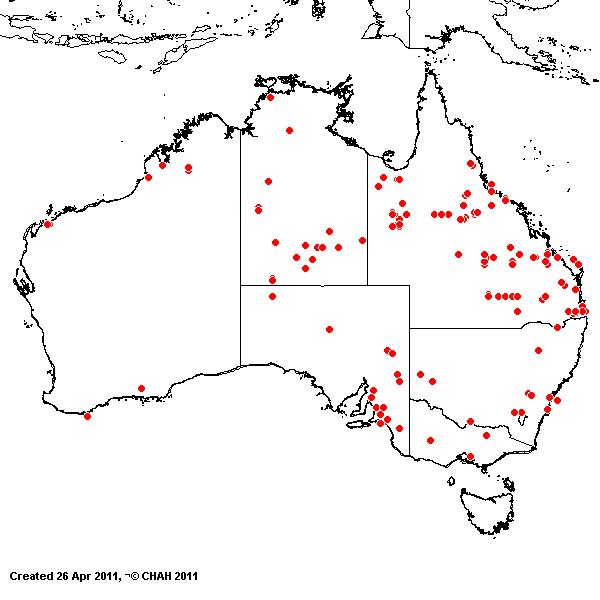Eragrostis minor* Host. Icon. Gram.
Austr. 4: 15 (1809).
Classification. (GPWG 2001) : Subfamily
Chloridoideae. Cynodonteae.
Basionym and/or
Replacement Name: Poa eragrostis
L., Sp. Pl.
68 (1753).
Type of Basionym or
Protologue Information: Habitat in Italia supra muros, D. Baeck s.n..
Recent synonyms:
E. pooides.
Key references
(books and floras): [2002] D.Sharp & B.K.Simon, AusGrass, Grasses of
Australia,
[2006] J.Jessop, G.R.M.Dashorst, F.M.James, Grasses of South Australia
(377), [2008] S.W.L.Jacobs, R.D.B.Walley & D.J.B.Wheeler, Grasses of New
South Wales (255).
Illustrations:
[2005] K.Mallet (ed.), Flora of Australia 44B: Poaceae 3
(Fig. 70E-F), [2006] J.Jessop, G.R.M.Dashorst, F.M.James, Grasses of South
Australia (377, fig. 309), [2008]
S.W.L.Jacobs, R.D.B.Whalley & D.J.B.Wheeler, Grasses of New South Wales,
4th edn (255).
Habit. Annual.
Culms erect or geniculately ascending or decumbent or prostrate, 6–60 cm tall.
Ligule a fringe of hairs, 0.3–0.5 mm long. Leaf-blades straight, flat or
involute or convolute, 3–12 cm long, 1–6 mm wide.
Inflorescence.
Inflorescence compound, a panicle. Panicle ovate, dense or loose, 4–20 cm long.
Spikelets.
Spikelets pedicelled. Fertile spikelets many flowered, with at least 2 fertile
florets (6–16(-40)), comprising 6–16(–40) fertile floret(s), with diminished
florets at the apex, linear or oblong, laterally compressed, 3–9(–15) mm long.
Glumes. Glumes
similar. Lower glume ovate, keeled, 1-keeled, 1–3 -nerved. Upper glume ovate,
1–1.9 mm long, keeled, 1-keeled, 1–3 -nerved.
Florets.
Fertile lemma 1.5–2 mm long, keeled, 3 -nerved. Anthers 3. Grain 0.7–0.8 mm
long.
Continental
Distribution: Europe, Africa, Temperate Asia, Tropical Asia, Australasia,
Pacific, North America, and South America.
Australian
Distribution: Western Australia, Northern Territory, South Australia,
Queensland, New South Wales, Victoria.
Western
Australia: Avon. Northern Territory: Darwin
& Gulf, Victoria River, Central Australia North, Central Australia South. South
Australia: Flinders Ranges, Eastern, Northern Lofty, Yorke Peninsula, Southern Lofty, South-eastern. Queensland: Burke, Burnett, Cook, Darling Downs,
Gregory North, Leichhardt, Maranoa, Mitchell, Moreton, North Kennedy, Port
Curtis, Warrego, Wide
Bay. New South Wales: North-Western
Plains. Victoria:
Gippsland Plain, Volcanic Plain, Wimmera.
Notes.
A troublesome weed.
Distinguishing characters include glands on
culms, leaves, pedicels, glumes and lemmas; plant often odorous; spikelets with
median depression, loosely imbricate florets and a vestigial terminal floret;
glumes cymbiform, often unequal, 1–3-nerved; lemmas almost as wide as long;
caryopsis rectangular, stipitate.
Introduced;
occurs in Broome in the N and near Salmon Gums in the SW, W.A.; scattered in
N.T. and southern S.A.; near Burketown across to Ingham and S to Brisbane, Qld;
Broken Hill, N.S.W., and around Horsham and Melbourne, Vic.; also occurs in
Papua New Guinea. Weed of railway tracks, cultivation and bores; also in
clearings in black clay plains and coastal vine thickest, on banks and in
seasonal watercourses, in valley of limestone ranges, and on white beach
sands.; flowers all year round but not recorded in Sept.-Oct.; fruits all year
round but not recorded in Sept.-Oct.






